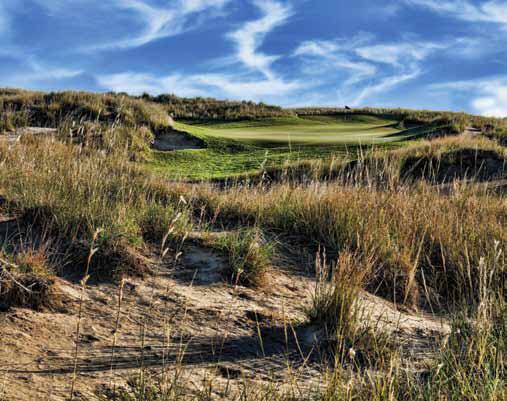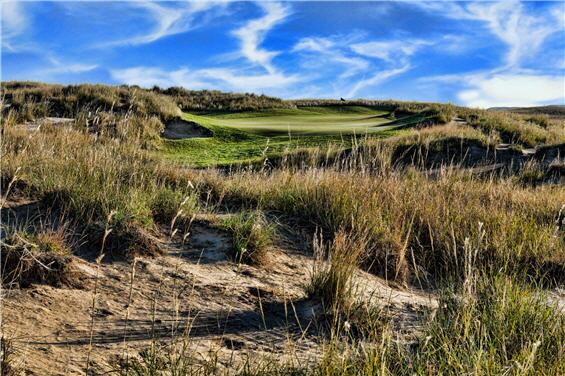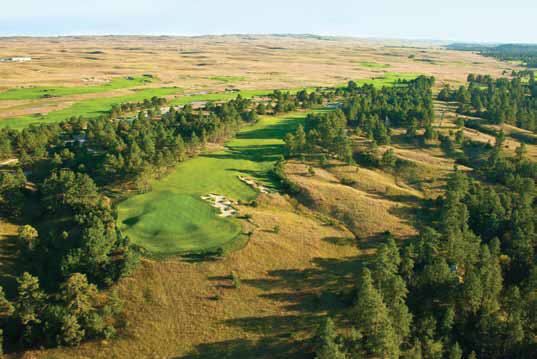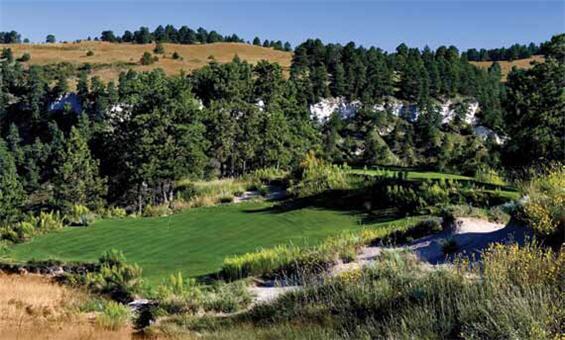Reprinted with permission from Golf Odyssey.

A large photo mounted in the lobby of the Prairie Club, the newest golf mecca in America's heartland, shows the property's dune-covered grassy sand hills as they appeared on the cover of a 1970s issue of National Geographic. Back then, there was no hint that the vast Sandhills region, the Western hemisphere's largest tract of stabilized sand dunes, would prove fertile ground for some of the best golf in the US.
For proof, all one needs to do is pay a visit to Sand Hills, Prairie Dunes, Dismal River, Ballyneal or the year-old Prairie Club to experience golf amidst heaving dunes and windswept terrain. Graham Marsh, who has done some fine golf course design work after a notable pro career, told us when we chanced upon him at the Prairie Club, “this is as close to the way golf was meant to be played as you'll find short of Scotland.” While somewhat of an overstatement, there is no doubt that the Prairie Club offers a compelling experience.
Unlike the other world-class links in the Sandhills region that are strictly private affairs, the Prairie Club welcomes anyone who ventures to this remote pure golf getaway on the rim of the Snake River Canyon in north-central Nebraska. Owner Paul Schock, who made his fortune as a venture capitalist but is also an accomplished amateur golfer and a member of Sand Hills Golf Club, saw the potential of the ranchland site for golf. Much like visionary Mike Keiser of Bandon Dunes, he strove to create affordable access to a world-class golf destination that “touches the soul of all those who journey here.” The Prairie Club comprises two rousing eighteens—the Tom Lehman-designed Dunes Course and the Graham Marsh designed Pines Course—as well as a unique 10-hole par-three layout by Gil Hanse. Other than the fact that the regulation courses are par 73s that were built with minimal earth moving and no water hazards, they're quite different. The broad-shouldered Dunes Course is Lehman's ode to the Sandhills. Gargantuan fairways and hundreds of naturalistic bunkers rise and fall with the dunes en route to dramatic and swift oversized greens that may be best approached via the ground. Marsh's layout, which at times approaches the canyon rim, alternates between exposed treeless holes and traditional tests routed through tall pines. A third eighteen, Old School, is also in the works from the team of Gil Hanse and Geoff Shackelford.
Each day, one of the Prairie Club's two eighteens is reserved exclusively for members, while the other is open to the public. Those who book a stay & play package are permitted unlimited golf (just pay the cart fee) all day on the public course both the day of arrival and the day of departure. Given the 36-hole-a-day tenor of the club and the absence of other diversions (shopping, spa, a swimming pool, etc.) either in-house or anywhere nearby, the Prairie Club is likely to remain a buddy retreat for those who like total golf immersion.
Although Valentine (population 3,000) has long been a popular spot for campers and others who enjoy canoeing, kayaking, or floating on inner tubes or giant plastic tanks down the waterfall-laden Niobrara River, the area is not used to high-end tourism. Among the locals on staff at the Prairie Club's lodge, there's still a bit of bewilderment that their corner of the world is a budding mecca for world-class golf. This year, the Prairie Club brought in almost an entirely new staff to lend more professional service to sophisticated traveling golfers who may fly privately and who are used to top-shelf facilities and amenities. The operation is still a work in progress, but everyone we met was very friendly and eager to help make our stay as enjoyable as possible.
The golf season runs from mid to late April through late October. During our late-May visit, temperatures were quite cool (highs only in the low 60s). We even encountered a frost delay. Summer can be brutally hot, albeit without humidity. The southwest wind hits like a blast furnace and temperatures can top 100. The best time to visit is September and early October. During this interval, the winds are usually down and temperatures are more moderate.
By far, the most convenient way to get to the Prairie Club is to fly privately to Valentine airport and have the club pick you up and take you the 17 miles to the clubhouse and lodge. Myriad commercial options exist, but none are all that convenient. Denver is the closest hub, but it is six and a half hours away (not an unduly long haul by Western or prairie standards). Within Nebraska, itself, the closest commercial airport is North Platte, though Grand Island, Lincoln, or Omaha also may suffice. Those driving from eastern Nebraska would be well-suited to exit Interstate 80 near Gothenburg for a round at Wild Horse Golf Club, often billed as the “public” or “poor man's” Sand Hills. You shouldn't rule out flying in and out of South Dakota, either (Sioux Falls – 4 ½ hours; Rapid City 3 ½ hours; Pierre 2 ½ hours). We ultimately decided to fly through Rapid City, a gateway to Mount Rushmore, Custer State Park, and the spectacular Badlands National Park. Be advised that the Denver and Rapid City airports are in the Mountain time zone.
________________________________________
THE GOLF
The Dunes Course (Rating: A-), a Tom Lehman creation, is the Prairie Club's signature eighteen. It features very wide, wind-exposed fairways—often more than 100 yards wide—hundreds of waste and sand bunkers (on the order of Whistling Straits), and gargantuan greens. Many shots into the greens are uphill and balls that come to rest in low spots on the up and down landscape often result in a partially blind approach. Since the turf on the treeless terrain plays fast and very firm (during our spring visit, the golfing grounds were still a far cry from their summer firmness), you should plan for considerable run on the ball. Putting from many yards off the green is usually an option.
The notorious winds of the Sandhills, along with Lehman's bunkering, provides the principle defenses against par. Three- or four-club winds are commonplace. During our rounds, when the currents blew steadily at 20 miles-per hour, our caddie dismissed them as “nothing” for this corner of Nebraska. Each day's course setup is largely predicated on the ferocity of the wind and the firmness of the turf. Lehman built up to eight tee boxes for every hole to ensure that the course, which most members play at 6,838 yards, would be manageable in all conditions.
The opening hole begins well away from the clubhouse. Even if you're walking, you'll need to drive a cart out to the tee boxes. Like so many holes on the Dunes Course, elevated tee boxes offer a downhill tee shot before the fairway climbs to an elevated green. The wide punchbowl fairway presents an inviting target, but at all costs avoid the large and deep bunkers. Occasionally during the round, those who play from the back tees face formidable carries over transition areas and the native grasses to reach the groomed turf. Hole 3 is the first of five par fives on the Dunes Course. Most play uphill and long, so don't expect to get home in two. Position “A” off the tee is to the upper or left shelf of the fairway. On the second (or third) shot, anything left of the fairway ridge will trundle far down to a portion of groomed turf, or, if you're unlucky, longer native grasses.
On the par-three 4th, Lehman provides a hint of just how large the greens on the Dunes can be. A ridge divides the 80-yard-deep hourglass-shaped putting surface in two. The contouring at the middle and back left will feed balls toward the center of the green. Don't be short, as the bunker features are severe. The sand tends to be a little heavier than what you find in many parts of the country, but because of the wind and the natural blowout of the bunkers, be sure to note how much sand is actually present. Thankfully, most bunker areas are considered waste areas and do not require raking.
The toughest stretch on the Dunes comprises the par-four 8th and 9th and the par-five 10th, rated the number 1, 3, and 2 handicap holes, respectively. The very long 8th cants from right to left in the wide landing area, but a blowout-lined gap, hillsides, and bunkers complicate the approach.The final six holes all play into the prevailing wind as the Dunes Course heads back toward the clubhouse. Thirteen is a very pretty hole with eight fairway bunkers. Fifteen is an uphill double dogleg par five. Three successive bunkers up the right side may induce you to play out to the left, but you'll make the hole a lot longer if you do. Provided you get past the false front, the contoured sides of the green funnel balls toward the center. If you've been waiting for a bit of shelter from the wind, the teeing areas on holes 17 and 18 sit in dune-guarded hollows. Of course, your drive will still face the brunt of the opposing currents.
The Dunes Course was originally designated walking-only, but the members quickly demanded carts be allowed because of the severity of the terrain and the distance between a few greens and tees. We walked with a caddie, who informed us that it's an 8.4-mile trek. We didn't think it was too taxing, but you'll know you've been walking when you're done.
The Pines Course (Rating: A-), a Graham Marsh design, isn't as dramatic or unique as the Dunes Course, though it is the preferred course among Prairie Club members. Alternating between wide-open grasslands and tree-lined stretches that are somewhat sheltered from the wind by tall pines makes for nice variety and appealing aesthetics. The course differs from the Dunes Course in many ways. With less elevation and flatter terrain, blind shots are minimized. The greens (smaller in size, but still about 35 to 40 yards deep) feature harder edges and pronounced knobs that deflect balls. It is also a much easier course to walk.

The 5,345- to 7,403-yard routing begins in open and exposed grassy prairie land. On the straightaway par-four 4th, the windmill in the distance can be a target off the tee. The hole normally plays downwind and balls seem to roll forever. As will be repeated throughout the round, the trap that appears to be placed right in front of the green is some 20 yards back in the fairway. The wide but shallow green is full of rolls and ridges.
If you look through the trees behind the green on the par-three 6th you can get your first glimpse of the Snake River Canyon to the right. (This is not the Snake River Canyon Evel Knievel famously failed to jump.) The hole maxes out at 159 yards, but the green, the most extreme on the course, features a wicked false front.

Holes 5 through 12 play amidst the trees. Fairways 8 and 9 are side by side, forming as wide a target landing area as you'll find on the Pines Course. The short downhill and downwind par-four 9th is drivable for long hitters. The green is narrow with sand and native grasses to the rear and yet another devilish false front.
Arriving at the par-four 13th, the Pines Course returns to exposed prairie land. Among Marsh's open holes, this is the most aesthetically pleasing. He takes advantage of the natural contours and frames the green with a rear bunker that really doesn't come into play.
The last three holes play amidst trees. The par-four 16th is an attractive straightaway tree-lined two-shotter with a scenic backdrop. The round concludes with a strong par five that offers multiple strategic options. The safest tee shot on this dogleg left favors the right side, but if you want to try to get home in two you must cut the corner. The layup can be difficult from the right, as it looks quite narrow. The last 130 yards climb to a well-defended green that falls off at the rear. Be advised that if you don't make the carry to the green on the left, you'll be in tall grass and snake territory.
The first time your group plays a course at the Prairie Club, you must utilize a forecaddie. Walking caddies are also available. Management of the Prairie Club's caddie program has just been taken over by Caddie Master, which supplies caddies to Kiawah Island's private courses and Reynolds Plantation, among others. We had good experiences with Andrew, who grew up in the area and spends half the year at Whisper Rock Golf Club in Scottsdale, and Nigel, who started his caddie career at The White Witch in his native Jamaica.
Course conditioning at the Prairie Club is generally excellent. The greens, which utilize a new T-4 bentgrass, roll true. Harsh temperatures and heavier (and later) snowfall than normal caused some winterkill that was still evident on the Dunes Course. On the Pines Course, mowers that don't hit the knobs in the greens delicately enough occasionally leave bare spots. The big news, however, in terms of course playability, is the decision to cut the native grasses. Last year, the high grass began right beyond the fairways and was allowed to grow all season. The result—many lost balls and slow play. This year, there's generally some room beyond the fairway before the tall grass holds sway. At least early in the season, the tall grass was being cut back.
Practice facilities are excellent, highlighted by the Horse Course. This 10-hole, par-three course has no formal tee markers. Like the basketball game of the same name, the Horse Course teeing areas are established from wherever the player who has the honors chooses. The greens may be smaller than you'll find on the championship courses, but they are maintained to the same standards, and the bunkering can be just as tricky. A couple of holes descend into the canyon. While you may only need three or four clubs, bring at least that many balls. This is an excellent course for practicing your short game and ideal for some pre-dinner wagering. You should be able to get around in about an hour. Play is complimentary for Lodge guests.

________________________________________
LODGING
The home base of the Prairie Club (Rating: B-) is the three-story Lodge, which houses the golf shop, the club's bar and dining venues, and individual guestrooms. Guestrooms are on the first and second floors. The third floor features the library, the conference rooms, and the Eagles Nest, a lounge reserved exclusively for members.
Lodge accommodations are somewhat unconventional, but suitable for short, golf-centric visits. In addition to standard single rooms, there are also singles with a shared bathroom. The shared single rooms are packed tightly with a king-size bed, a 26-inch flat-screen television, a small desk, and a vanity. One could easily feel claustrophobic, but then again, most guests don't spend much time in the rooms anyway. The double rooms are also configured uniquely. Instead of side-by-side beds, the beds are situated on opposite sides of a large room so only one has a comfortable view of the television. Be advised that there's not a single bathtub in any of the guestrooms at the Prairie Club.
Just days after our visit concluded, the Prairie Club unveiled its new four bedroom Canyon Rim Cabins. Located behind the lodge, each cottage features a common living area and a porch as well as bedrooms that have their own bathrooms. All the bedrooms have private key locks.
________________________________________
RESTAURANTS
Dining at the Prairie Club (Dining Rating: B-) is a work in progress. The menus are not fancy, but the cooking is straightforward and perfectly satisfactory. The portions are quite hearty. Guests have the option of sitting in the bar area or in a more formal dining room.
Breakfast is a buffet that, while not overly extensive, includes all the basics as well as a daily feature entrée that, in truth, isn't so special. At dinner, the emphasis is on steaks and local game and fowl. Among the appetizers, try the Bull Bites, pan-seared pieces of Angus beef (a half order should do). A bowl of the Southwest Chicken Tortilla soup is practically a meal in itself. Among the main courses, you won't go wrong with the buffalo top sirloin or the pan-seared walleye served with citrus beurre blanc, fingerling potatoes, sun-dried tomatoes, and sautéed spinach. Alas, the wine list is modest.
________________________________________
NON-GOLF ACTIVITIES
The Prairie Club is about golf, little else. The most enjoyable—and impressive pastime is stargazing on a clear night. Members make their way to the Eagles Nest, which has a bar, television, and a pool table. If you want to watch a game that may not be on the limited channels available in your guestroom, you can try the bar or the library, both of which have satellite television. A pool table would make a nice addition to the library. If one happens to have the desire to work out, a small window-less exercise room contains a few cardio machines and weights.
The Valentine area doesn't offer much in the way of shopping or entertainment. If you somehow don't feel like golfing, you can try floating on the Niobrara River. Fly-fishing is also excellent in the area.











